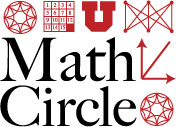2012-2013
|
Oct 10 (First Meeting) |
| Symmetry in three dimensions
|
The main problem we investigated was the classification of all finite, connected graphs (with no self-loops or multiple edges) in which each vertex v is labeled with a positive integer so that the label at any vertex v is one-half the sum of the labels of the vertices connected to v. We decided it was a good idea to also require that there is a special vertex labeled 1*. We derived the classification (the diagrams labeled ADE here or here) and noted the peculiar three exceptions which emerged (with 7, 8, and 9 vertices). We then considered a new problem: find all finite lists of rotations in three dimensions (about an axis through the origin) so that the composition of any two rotations on the list is once again on the list. That's where we will start next time. Oct 24 |
| Symmetry in three dimensions (continued)
|
We returned to the question of lists of rotations mentioned above. The first thing we decided is that it would be a good idea to consider two lists the same if there were a "change of coordinates" taking one to the other. The next things we observed is that there is a nice way to build lists with the property that if two elements are on the list then so is their composite. The idea is to start with a blob B and consider the list of all rotations that take B to itself. If the blob B possesses no symmetry, then the list will consist of one element (the "do-nothing" rotation). On the other hand, if the blob B possesses too many symmetries (for example, if the blob is a perfect sphere), then the list will be infinite. But for some choices of blobs, we will get an interesting finite list. We wrote down a number of such lists taking the blob to be a perfect n-gon, a perfect n-gon with its "top" painted a different color than its bottom, a cube, octahedron, tetrahecdron, dodedcahetron, and icosahedron. We gave a nice argument to see that the cube and octahedron gave the same list, and so did the dodecahedron and icosahedron. Then we checked that (apart from the coincidences just mentioned) the lists were all different. So we ended up with two infinite families (the n-gon and painted n-gon) and three interesting exceptions (the tetrahedron, cube=octahedron, and icosahedron=dodecahedron). We weren't able to prove this, but in fact this is a complete set of all such finite lists of rotations so that the composition of any two rotations on the list is once again on the list. The remarkable observation is that the answer is "the same" as the answer to the graph question we considered two weeks ago! We discussed what this might mean.
Nov 7 |
|
The method of cyclic differences
| Start by drawing a large quare and choosing four whole number to place at the corners. At the midpoint of each edge, write the absolute value of the difference of the adjacent vertices. Then draw a new square through the midpoints and continue the process. Stop when you reach a square whose vertices are all labeled 0. Does this process always stop? What about if you started not with integer labels but real numbers instead? We discussed this problem in detail, mostly following the notes Diffy Boxes (Iterations of the Ducci Four Number Game) but also the discussion on the New York Times Wordplay page. We also considered the following problem. A number of students sit in a circle facing their teacher in the center. Each student initially has an even number of pieces of candy. When the teacher blows a whistle, each student simultaneously gives half of his or her candy to the neighbor on the right. Any student, who ends up with an odd number of pieces of candy, is given another piece by the teacher. The game ends when all students have the same number of pieces of candy. Does the game always end? The method of solution was via a technique similar to the analysis we used when discussing the difference boxes. Next week we'll consider continuous analogs of these problems.
Nov 21 |
| The method of cyclic differences (continued)
|
Ten trolls sit around a campfire, each with a bowl of gruel. They play a game where each time the fairy princess rings a bell, each troll passes half of his gruel to bowl on his left. The princess agrees to stop the game once every troll has the same amount of gruel in their bowl. Assuming that at least one troll began with more gruel than his neighbors, does this game ever stop?
Dec 12 |
| Parking sequences
|
This week we followed Elgin Johnston's notes Where Can I Park?
Jan 30 |
| An interesting way to combine numbers
|
We followed the notes of Tom Davis and Josh Zucker An interesting way to combine numbers. The tired old concepts of associativity and commutativity took a star turn, and we started digging deeper into the theory of symmetric functions.
Feburary 27 |
| Picture proofs in probability
|
|
||
- campus: a to z index
- map
- directory
- calendar


